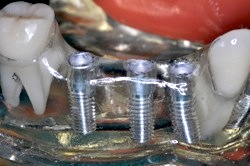Dental Implants
For the person who has missing or has lost permanent teeth, dental implants are designed to provide a foundation for the replacement teeth that look, feel and function very much like natural teeth. Dental implants offer the chance to regain the ability to eat normally with teeth that appear as natural as possible. Dental implants are long-term replacements that are surgically placed into the jaws. Dental implants are changing the quality of life for people to chew and smile with greater ease and confidence. Dental implants can also help to preserve the bony structure of the jaws by preventing bone deterioration that occurs when natural teeth are missing.
What are Dental Implants?
Dental implants are composed of titanium metal that fuses with the bone of the jaws in a process called osteointegration. Dental implants allow missing teeth to be replaced that do not slip or cause embarrassing clicking sounds while eating or speaking like removable dentures can. The main advantage to the dental implant replacement of missing teeth is that implants do not involve the adjacent healthy teeth as if a fixed bridge is placed to replace a missing tooth. If properly cared for, dental implants can last a lifetime.
Dental implant replacement of a natural tooth involves three parts: the titanium implant that fuses with the bone of the jaws; the abutment which fits into the implant and protrudes through the gum; and the crown which is created by your Dentist and is fitted onto the abutment. The crowns that are attached to the abutments restore your smile and chewing function.
If several teeth are missing, two or more dental implants can be placed depending upon the number of teeth missing.
The Surgical Procedure
Dental implants can be placed into the bone of either the upper or lower jaw. The implants are placed into the appropriate position in the dental arch to replace the missing root foundation. Osteointegration of the dental implant in the lower jaw requires three months of healing. Five to six months of healing are required to allow adequate integration in the upper jaw. During this healing phase, it may be possible to wear a temporary tooth replacement. Once the implant has bonded to the bone, the abutment is then inserted into the implant. Your Dentist will then take an impression of the abutment and have a crown constructed to fit over the abutment.
There are some situations where a dental implant can be placed at the same time as the extraction of the tooth that the implant will replace. Simultaneous placement minimizes the number of surgical procedures to be performed and helps to minimize the number of appointments needed.
If you have questions regarding the dental implant replacement of missing teeth, please call for a consultation appointment with Dr. Henry at (603) 352-1973.
Dental Implants FAQ’s
Why dental implants?
When you lose one or more teeth you may notice a decrease in chewing efficiency, avoid certain foods, and may experience less confidence when you smile. Implants offer a means to replace missing teeth in a way that most closely mimics natural teeth. Who actually performs the implant treatment? Dental implant treatment involves a team effort between the Oral and Maxillofacial Surgeon and your restorative Dentist. While Dr. Henry performs the initial tooth extraction and bone grafting if necessary prior to actual implant surgery, your Dentist will place the abutment(s) and makes the final crown(s). Your Dentist may also fabricate a temporary tooth replacement during the implant healing phase.
What types of prostheses are available?
A single prosthesis (crown) is used to replace one missing tooth. A fixed bridge prosthesis can replace two or more teeth and may require only two or three implants (generally less then the number of teeth being replaced). The number of implants needed will vary depending upon the number of teeth missing. A complete prosthesis (removable or fixed) can be made if an entire upper or lower dental arch needs replacement. A removable prosthesis (over denture) attaches to a bar or ball in socket attachment for stability, whereas a fixed prosthesis is permanent and removable only by the Dentist.
Why choose dental implants over more traditional types of restorations?
At the most basic level, implants replace the support system originally supplied by the roots of teeth. By doing so, they allow fixed or removable dental prosthesis to be self-supporting. Dental implant placement eliminates the need to involve the adjacent teeth as when making a fixed dental bridge. Implants can help to anchor and stabilize removable restorations such as partial or full dentures in a manner that would not otherwise be possible.
Are you a candidate for implants?
If you are considering implants, your mouth must be examined thoroughly and your medical and dental history reviewed. Most patients do have adequate residual bone in the area to support implant placement. If your mouth is not ideal for implants, there are techniques available to improve your chance of having implants, such as bone grafting.
What type of anesthesia is used?
The majority of dental implant and bone grafting procedures can be performed in the office under local anesthesia. If desired, nitrous oxide or intravenous anesthetics may also be options to consider.
Do Implants require special care?
Once the implants are in place, they should serve you well for many years. Routine oral hygiene with brushing and flossing, and keeping regular cleaning appointments with your Dentist will help insure the success of your dental implant.
Where is treatment performed?
Dr. Henry performs in-office dental implant surgery.
What type of dental implants are available?
There are many different manufacturer's of dental implants. We commonly place Straumann (www.straumann.com) dental implants based on the preferences of our referring Dentists.

Dental Implants on Surgical Model

Abutments on Dental Implants

Crowns on Abutments